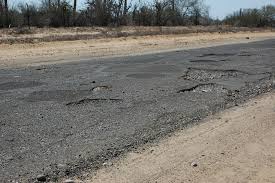
Road state changes include jolts, slips, ruts, white lines, ice and gravel. The worst are those you don’t see in advance, like oil slicks. Understanding the road means knowing where such changes are likely to occur so you can be prepared. Road state affects riding so be ware of the road at all times for changes in state and adapt.
Jolts
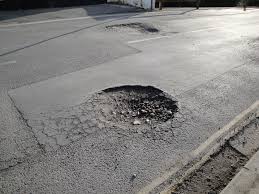
Jolts are caused by pot-holes or obstacles in the road that suddenly shock the bike. A jolt from hitting an object like a dead animal in the road can twist the bike so it falls or even throws you off. If you see a pothole, slow down and try to avoid it, but if you cant then at least hit it straight on. This avoids the twist and fall problem. Just before you hit, you can raise your body slightly with your legs to absorb some of the shock, and use bendable arms to absorb any forward shock. If a jolt lifts you off the seat don’t panic as the law of gravity will return you to the bike if it is straight. If you are cornering and meet a jolt, first slow down and straighten up, then as above.
Ruts
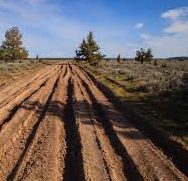
Ruts are ridges or channels in the road that take control of the bike and move it in the direction of the rut. On unpaved roads, ruts are commonly caused by water or wheels. On modern roads they can occur when lanes on highways are laid down separately and split apart over time. Tramlines also create a rut problem. If your front tire gets in a rut it will follow the rut, and often there is not much you can do about it. You have to follow the rut until you regain control. Dont try to fight it, as that can make things worse. Hitting a rut while turning a corner can be disastrous, as the rut sends the wheels one way and forward motion sends the bike another, flipping it to the ground. If you see a rut on a turn, slow and straighten immediately. If you are riding where there are ruts, be aware how dangerous they are. To cross a rut, increase the angle across it. So if there is rut between two lanes on a highway, turn into the other lane at a greater angle than you normally would.
Grills
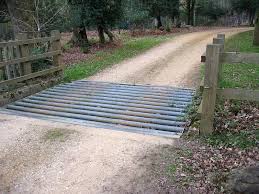
Grills are like minor ruts that interfere with bike control. They occur on bridges where the engineers put down steel ridges instead of asphalt for service reasons. As you cross the bridge you feel the grill ridges controlling your tires in the direction of the grill. Slow down, and try to drive in the direction of the grill. Don’t try to fight it. If you point the bike in the same direction as the grill, there will be some wobble but not much. It is disconcerting, but not dangerous. Another type of grill is a cattle grill that stops cows from walking over it. If you cross the grill at right angles there is nothing to worry about – it will just bump the bike up and down a bit, thats all.
Slips
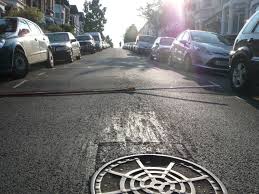
Slips are parts of the road that have less friction. They include oil, ice and white lines. If you are riding straight ahead at a constant speed, a slip is not a problem as you just slide on over it, but if turning, stopping or accelerating they are a problem. A turning bike that hits a wet manhole cover can slip and fall. If the slip is brief the bike will recover, unless you are pushing the envelope or overreact. Worse than small manholes are the large metal panels sometimes used to cover road repairs. If you hit one of those on a turn, then you have a problem. But like all things what you see coming isn’t a problem – just take the turn slower or straighten up over it.
Oil patches
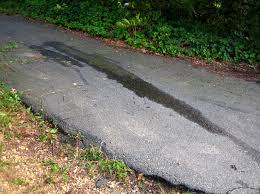
Oil patches are another type of slip but are hard to see, so know where they are likely to be. Oil leaks from cars occur in the middle of the road, or where cars often wait. For example at toll booths, the center can be an oil slick so slippery you could not even stand there, so keep to the side. Likewise at stop signs or traffic lights, there is often an oil slick front and center. This position is not where you want to accelerate off from.
Straighten up
The solution to every case of turning on a slippery surface is to straighten and not accelerate or brake. You have to go straight across a slip. If anyone has a better solution, let me know. After the slip, you can turn again. If you feel a slip rather than see it, the response is the same – straighten up immediately. Bringing the bike upright in a slip usually restores stability, and then you have other choices like to brake or turn again.
White lines
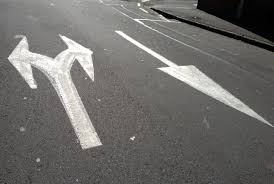
White lines, or any kind of road marking, are a special case of road slip. When you ride over road markings, especially in the rain, your friction is much less. If you apply the brakes, you may slip. In general keep your bike off road markings for this reason. Definitely don’t brake heavily while on the white lane direction arrows. If overtaking, keep off the lines separating the lanes. If stopped, keep your back tire off the stop line. This advice applies double in the wet. If your back tire is on a white line at a traffic light, and you accelerate off when the light turns green, there is a good chance you will skid. When the bike is on a painted road marking you are in “slip alley”.
Ice
When traveling over ice, you have no control at all. You had better believe that ice is the perfect slip. The effect of ice is no friction, so you cannot turn, accelerate or stop. If you hit ice, all you can do is try to keep straight and steady. My advice regarding ice is DON’T RIDE. I ride in snow, rain, wind and storm, but in ice, I stay home. Clear day with snow on the ground – no problem. Pouring rain – fine. Thunder and lightening – I have rubber wheels. But if there is ice on the road, take the train.
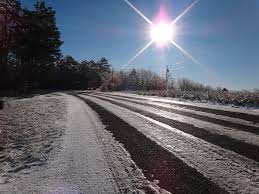
Even though I dont ride on ice, I have ridden when there was salt on the roads so the ice was patchy. The best bet is to stick to often used roads, as the cars using it melt the ice, and car tires can clear ice. When they salt the roads take the main roads and avoid side roads that are salted less frequently. Take the most traveled route, and stay in the vehicle tracks not the road center. Then remember not to go out on ice again.
Gravel
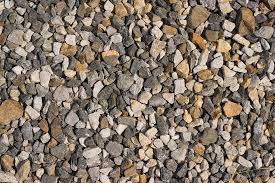
Gravel and dirt are not really slips but they behave the same. Gravel is an unstable surface that moves if pressured in any way. If you try to turn in gravel the front wheel slips away and the bike goes down. So as with slips, keep straight until you can slow down. Some people like gravel, but most of us prefer to avoid it, which means knowing where it is. Most gravel sits on the side of the road. If you pull off a highway for any reason, beware of gravel and keep straight and stop slowly. Sometimes gravel is where you might not expect it, for example it builds up at the points between the flows on major intersections where car tires push it. So there can be gravel right in the center of an intersection, where the cars dont go. Watch out for these “gravel accumulation points”.
Debris
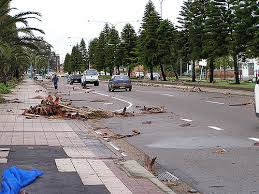
Road debris sitting on the road can fly through the air and hit you when a car runs over it. Maybe it fell off the back of a truck or an insecure trailer. Then cars ride over it until it disappears. If you see debris in the road there is not a lot you can do except prepare for a jolt, i.e. keep straight and let your legs absorb the jolt. If debris flies through the air at you, just duck, or drop your head forward momentarily to present a smaller profile. It then hits your helmet top rather than your visor.